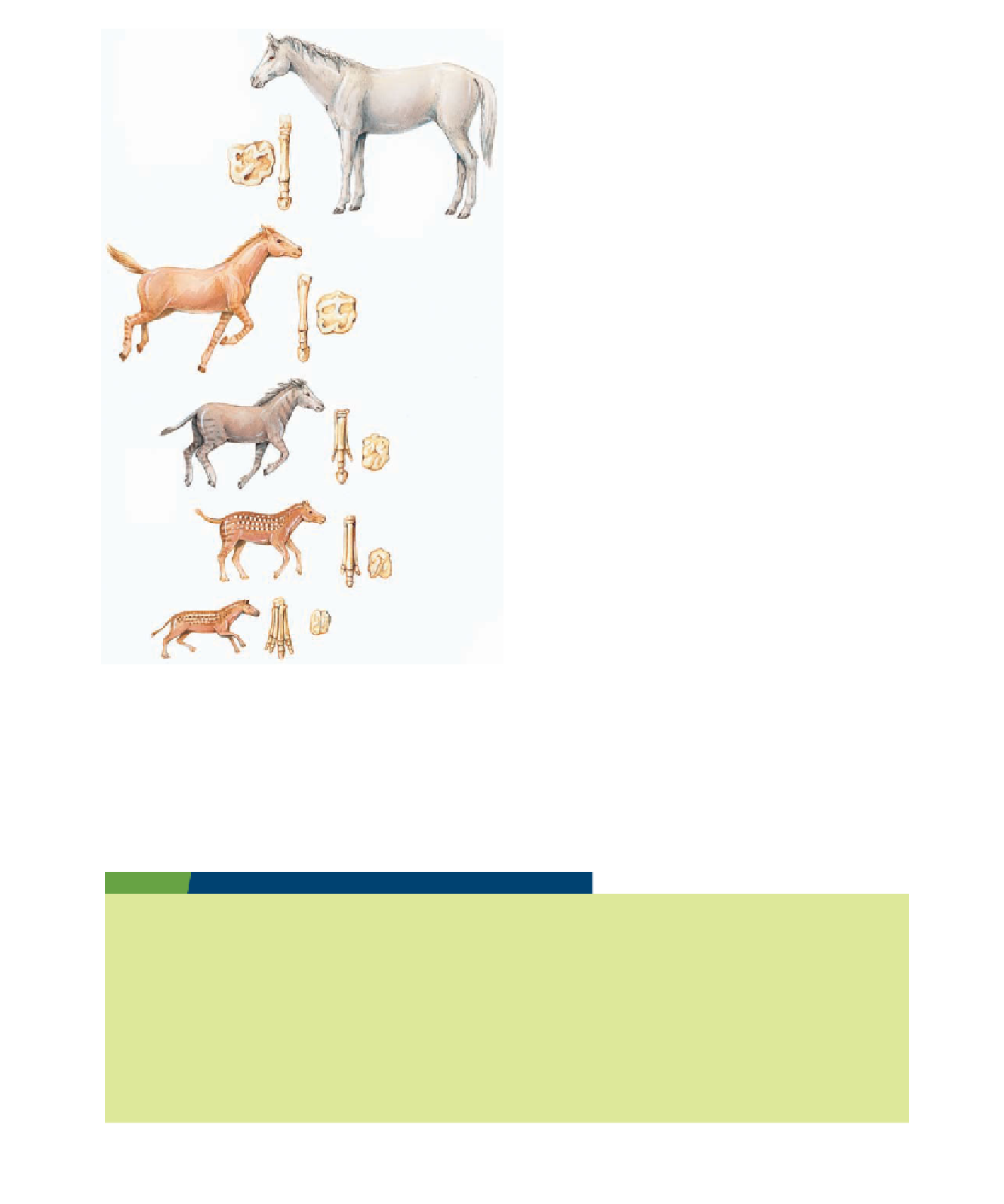Geology Reference
In-Depth Information
The evolutionary trend toward large body size was perhaps
an adaptation to the cooler temperatures of the Pleistocene.
Large animals have proportionately less surface area com-
pared to their volume and thus retain heat more effectively
than do smaller animals.
In addition to mammals, some other Pleistocene ver-
tebrate animals were of impressive proportions. The giant
moas of New Zealand and the elephant birds of Madagascar
were very large, and Australia had giant birds standing 3 m
tall and weighing nearly 500 kg and a lizard 6.4 m long and
weighing 585 kg. The tar pits of Rancho La Brea in southern
California contain the remains of at least 200 kinds of ani-
mals. Many of these are fossils of dire wolves, saber-toothed
cats, and other mammals (
Equus
(Pleistocene)
Pliohippus
(Pliocene)
Figure 23.28), but some are the
remains of birds, especially birds of prey, and a giant vulture
with a wingspan of 3.6 m.
◗
Primates
are diffi cult to characterize as an order because they
lack the strong specializations found in most other mamma-
lian orders. We can, however, point to several trends in their
evolution that help defi ne primates and are related to their
ar-
boreal,
or tree-dwelling, ancestry. These include changes in the
skeleton and mode of locomotion; an increase in brain size; a
shift toward smaller, fewer, and less specialized teeth; and the
evolution of stereoscopic vision and a grasping hand with an
opposable thumb. Not all of these trends took place in every
primate group, nor did they evolve at the same rate in each
group. In fact, some primates have retained certain primitive
features, whereas others show all or most of these trends.
The primate order is divided into two suborders, the
Prosimii and Anthropoidea (Table 23.2). The
prosimians,
or
lower primates, include the lemurs, lorises, tarsiers, and tree
shrews (
Merychippus
(Miocene)
Mesohippus
(Oligocene)
Hyracotherium
(Eocene)
Figure 23.29a). They are generally small, ranging
from species the size of a mouse up to those as large as a
house cat. They are arboreal, have fi ve digits on each hand
and foot with either claws or nails, are typically omnivo-
rous, and most are nocturnal. As their name implies (
pro
means “before,” and
simian
means “ape”), they are the old-
est primate lineage, with a fossil record extending back to the
Paleocene.
◗
◗
Figure 23.25
Evolution of Horses Simplifi ed diagram showing
some of the trends from the earliest known horse to the one-
toed grazing horses of the present. Trends shown include size
increase, reduction in the number of toes and lengthening of the
legs, and the development of high-crowned teeth with complex
chewing surfaces. Notice that
Merychippus
had three toes,
whereas
Pliohippus
had only one. Another evolutionary lineage
of horses, not shown here, led to the now extinct three-toed
browsers.
TABLE 23.1
Trends in the Cenozoic Evolution of the Present-Day Horse
Equus
1. Size increases.
2. Legs and feet become longer, an adaptation for running.
3. Lateral toes are reduced to vestiges. Only toe three remains functional in
Equus
.
4. The back straightens and stiffens.
5. Incisor teeth become wider.
6. Molarization of premolars yields a continuous row of teeth for grinding vegetation.
7. The chewing teeth (molars and premolars) become high-crowned and cement-covered for grinding abrasive grasses.
8. Chewing surfaces of premolars and molars become more complex, also an adaptation for grinding abrasive grasses.
9. Front part of skull and lower jaw become deeper to accommodate high-crowned premolars and molars.
10. Face in front of eye becomes longer to accommodate high-crowned teeth.
11. Brain becomes larger and more complex.

Search WWH ::

Custom Search